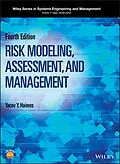Presents systems-based theory, methodology, and applications in risk modeling, assessment, and management
This book examines risk analysis, focusing on quantifying risk and constructing probabilities for real-world decision-making, including engineering, design, technology, institutions, organizations, and policy. The author presents fundamental concepts (hierarchical holographic modeling; state space; decision analysis; multi-objective trade-off analysis) as well as advanced material (extreme events and the partitioned multi-objective risk method; multi-objective decision trees; multi-objective risk impact analysis method; guiding principles in risk analysis); avoids higher mathematics whenever possible; and reinforces the material with examples and case studies. The book will be used in systems engineering, enterprise risk management, engineering management, industrial engineering, civil engineering, and operations research.
The fourth edition of Risk Modeling, Assessment, and Management features:
* Expanded chapters on systems-based guiding principles for risk modeling, planning, assessment, management, and communication; modeling interdependent and interconnected complex systems of systems with phantom system models; and hierarchical holographic modeling
* An expanded appendix including a Bayesian analysis for the prediction of chemical carcinogenicity, and the Farmer's Dilemma formulated and solved using a deterministic linear model
* Updated case studies including a new case study on sequential Pareto-optimal decisions for emergent complex systems of systems
* A new companion website with over 200 solved exercises that feature risk analysis theories, methodologies, and application
Risk Modeling, Assessment, and Management, Fourth Edition, is written for both undergraduate and graduate students in systems engineering and systems management courses. The text also serves as a resource for academic, industry, and government professionals in the fields of homeland and cyber security, healthcare, physical infrastructure systems, engineering, business, and more.
Autorentext
YACOV Y. HAIMES, PhD, is the Lawrence R. Quarles Professor at the School of Engineering and Applied Science, University of Virginia, USA, and is a member of the Systems and Information Engineering faculty and the Civil and Environmental Engineering faculty. He is the Founding Director (1987) of the university-wide Center for Risk Management of Engineering Systems. On the faculty of Case Western Reserve University, USA, for 17 years, he was the Chair of the Systems Engineering Department, and Director of the Center for Large-Scale Systems and Policy Analysis.
Inhalt
Preface to the Fourth Edition ix
The Companion Website xv
Acknowledgments xvii
Part I Fundamentals of Risk Modeling, Assessment, and Management 1
1 The Art and Science of Systems and Risk Analysis 3
1.1 Introduction 3
1.2 Systems Engineering 4
1.3 Risk Assessment and Management 14
1.4 Concept Road Map 26
1.5 Epilogue 35
References 35
2 The Role of Modeling in the Definition and Quantification of the Risk Function 41
2.1 Introduction 41
2.2 The Risk Assessment and Management Process: Historical Perspectives 43
2.3 Information, Intelligence, and Models 45
2.4 The Building Blocks of Mathematical Models 47
2.5 On the Complex Definition of Risk, Vulnerability, and Resilience: a SystemsBased Approach 51
2.6 On the Definition of Vulnerabilities in Measuring Risks to Systems 56
2.7 On the Definition of Resilience in Measuring Risk to Systems 57
2.8 On the Complex Quantification of Risk to Systems 60
References 65
3 Identifying Risk through Hierarchical Holographic Modeling and its Derivatives 69
3.1 Hierarchical Aspects 69
3.2 Hierarchical Overlapping Coordination 70
3.3 HHM 73
3.4 HHM and the Theory of Scenario Structuring 76
3.5 Adaptive Multiplayer HHM Game 79
3.6 Water Resources System 80
3.7 Sustainable Development 83
3.8 HHM in a System Acquisition Project 86
3.9 Software Acquisition 90
3.10 Hardening the Water Supply Infrastructure 94
3.11 Risk Assessment and Management for Support of Operations other than War 98
3.12 Automated Highway System 103
3.13 FoodPoisoning Scenarios 108
References 113
4 Modeling and Decision Analysis 115
4.1 Introduction 115
4.2 Decision Rules Under Uncertainty 116
4.3 Decision Trees 118
4.4 Decision Matrix 122
4.5 The Fractile Method 124
4.6 Triangular Distribution 127
4.7 Influence Diagrams 128
4.8 Population Dynamic Models 132
4.9 PSM 139
4.10 Example Problems 144
References 152
5 Multiobjective Tradeoff Analysis 155
5.1 Introduction 155
5.2 Examples of Multiple Environmental Objectives 157
5.3 The Surrogate Worth Tradeoff Method 159
5.4 Characterizing a Proper Noninferior Solution 166
5.5 The SWT Method and the Utility Function Approach 168
5.6 Example Problems 172
5.7 Summary 177
References 178
6 Defining Uncertainty and Sensitivity Analysis 179
6.1 Introduction 179
6.2 Sensitivity, Responsivity, Stability, and Irreversibility 180
6.3 Uncertainties Due to Errors in Modeling 182
6.4 Characterization of Modeling Errors 183
6.5 Uncertainty Taxonomy 185
6.6 The USIM 196
6.7 Formulation of the Multiobjective Optimization Problem 199
6.8 A Robust Algorithm of the USIM 204
6.9 Integration of the USIM with Parameter Optimization at the Design Stage 207
6.10 Conclusions 209
References 209
7 Risk Filtering, Ranking, and Management 211
7.1 Introduction 211
7.2 Past Efforts in Risk Filtering and Ranking 212
7.3 RFRM: A Methodological Framework 213
7.4 Case Study: An OOTW 220
7.5 Summary 224
References 224
Part II Advances in Risk Modeling, Assessment, and Management 227
8 Risk of Extreme Events and the Fallacy of the Expected Value 229
8.1 Introduction 229
8.2 Risk of Extreme Events 230
8.3 The Fallacy of the Expected Value 232
8.4 The PMRM 233
8.5 General Formulation of the PMRM 236
8.6 Summary of the Pmrm 238
8.7 Illustr...
